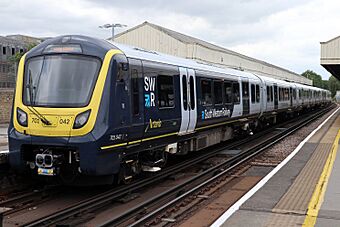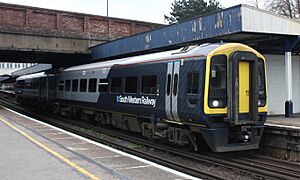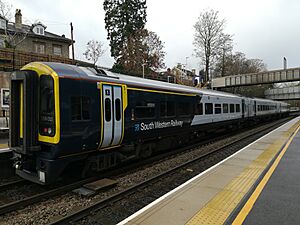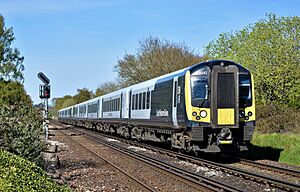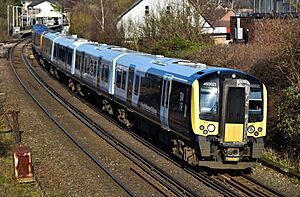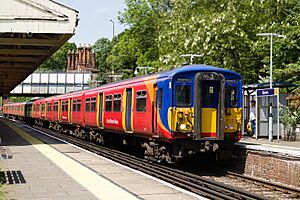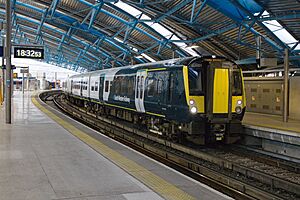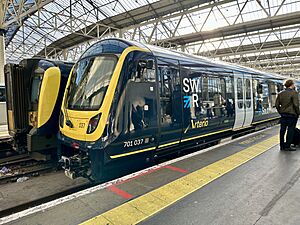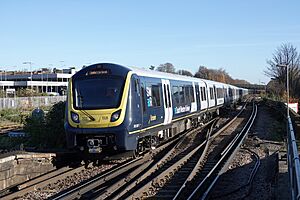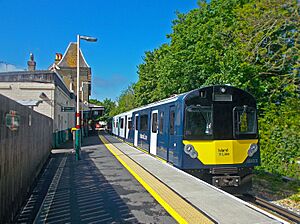South Western Railway facts for kids
South Western Railway (SWR) is a train company in Britain. It runs trains from London Waterloo to many places. These include south west London and areas like Surrey, Hampshire, Berkshire, and Dorset. SWR also has regional services in Devon, Somerset, and Wiltshire. On the Isle of Wight, it runs trains under the name Island Line.
SWR is a company owned by the government. It started running services on May 25, 2025. Before that, another company with the same name, owned by FirstGroup and MTR Corporation, operated these trains.
Contents
How South Western Railway Started
Before the 2024 United Kingdom general election, the Labour Party wanted to bring British railways back under government control. After they won the election, a new law was passed in November 2024. This law allowed the government to take over passenger train services.
In December 2024, it was announced that the contract for the previous South Western Railway would not be renewed. So, DfT Operator, a government-owned company, took over the services on May 25, 2025.
Train Routes and Services
South Western Railway is a major train operator in several parts of England. It covers western Surrey, Hampshire, Dorset, and the Isle of Wight. It also serves Greater London, Berkshire, Wiltshire, Somerset, and Devon.
Most SWR trains run on electric lines. These lines use a special system called the 750-volt DC third rail. Some trains use diesel engines. These diesel trains run on lines that are not electric. For example, they go to Salisbury and Exeter.
From London Waterloo, SWR's main London station, long-distance trains travel to southern England. They reach big cities like Portsmouth, Southampton, Bournemouth, Poole, and Weymouth. There are also trains to Reading and Exeter. However, other companies run the fastest trains to those cities from London. Most SWR passengers use the local trains in London and nearby areas.
You usually cannot take non-folding bikes on trains during busy times. This rule helps make sure there is enough space for all passengers. It applies to people getting on or off trains in certain busy areas.
Main Train Lines
SWR runs regular trains on four main routes:
- The South West Main Line (SWML) goes between London Waterloo and Weymouth. It passes through towns like Woking, Basingstoke, Winchester, Southampton, and Bournemouth. SWR runs trains along the whole line. Most trains start or end at Waterloo. Some trains also go to Portsmouth. They leave the SWML at Eastleigh and continue to Portsmouth Harbour station.
- The Portsmouth Direct line starts at Woking and goes to Portsmouth. It passes through Guildford, Haslemere, and Petersfield. SWR operates all passenger trains on this route. These include fast and semi-fast trains between London and Portsmouth.
- The West of England line is mostly not electric. It leaves the SWML at Basingstoke and goes to Exeter. It passes through Andover, Salisbury, and Yeovil. SWR is the only company on this line. Most trains run between London and Salisbury or Exeter St Davids.
- The Alton line leaves the SWML near Woking and goes to Alton. It passes through Aldershot and Farnham. This is the shortest main line. Trains usually run the full length between London and Alton.
In 2021, about 14 main line trains left London Waterloo every hour during off-peak times. This number increases during busy hours. Most main line trains are electric. However, the West of England Main Line uses diesel trains because it is not electric.
Local and Suburban Services
South Western Railway also runs many local "Metro" services around London. These trains run between Waterloo and Clapham Junction. From there, they split into two main routes: one via Putney and one via Wimbledon. All trains on these local routes are electric.
Via Putney
The main route through Putney is the Waterloo to Reading Line. It runs between London and Reading. It passes through towns like Staines-upon-Thames and Ascot. Branch lines on this route include:
- The Hounslow Loop Line. Trains on this line often run in a loop from Waterloo back to Waterloo.
- The Kingston Loop Line. Most trains on this line run in a loop from Waterloo, through Putney, Kingston, and Wimbledon.
- The Staines to Windsor Line. Most trains run between London and Windsor & Eton Riverside station.
- The Chertsey Branch Line. Most trains run between London and Weybridge.
- The Ascot to Guildford Line. This line has through trains only during busy times.
In 2021, 12 trains per hour ran between London Waterloo and Putney during off-peak hours.
Via Wimbledon
The main route through Wimbledon uses the slower tracks of the South West Main Line. Local trains run along this line between London and Woking. Branch lines on this route include:
- The Mole Valley Line. This line goes via Epsom to Leatherhead. From there, it splits to Guildford or Horsham.
- The Chessington Branch Line. This line leaves the Mole Valley Line and goes to Chessington.
- The Kingston Loop Line. Most trains on this line run in a loop from Waterloo, through Wimbledon, Kingston, and Putney.
- The Shepperton Branch Line. Most trains on this line run between Waterloo and Shepperton.
- The Hampton Court Branch Line. This line goes directly to Hampton Court.
- The New Guildford Line. This line also goes to Guildford via Claygate.
In 2021, 16 trains per hour ran between London Waterloo and Wimbledon during off-peak hours.
Other Train Routes
Some SWR train routes do not start or end at London Waterloo:
- The Ascot to Guildford Line runs between Ascot and Guildford.
- The western part of the West Coastway Line runs between Portsmouth and Southampton.
- The Eastleigh–Romsey line runs between Romsey and Eastleigh. These trains often continue to Salisbury.
- The Wessex Main Line runs between Salisbury and Southampton.
- The Lymington Branch Line runs between Brockenhurst and Lymington Pier every 30 minutes.
- The Island Line on the Isle of Wight runs between Ryde Pier Head and Shanklin.
Train Service Table
Here is a look at SWR train routes during off-peak times, Monday to Friday, as of May 2025. The numbers show how many trains run per hour (tph).
| Mainline services | ||
|---|---|---|
| Route | tph | Calling at |
| London Waterloo to Weymouth | 1 |
|
| 1 |
|
|
| London Waterloo to Poole | 1 |
|
| London Waterloo to Portsmouth Harbour | 1 |
|
| 1 |
|
|
| 1 |
|
|
| London Waterloo to Haslemere | 1 |
|
| London Waterloo to Exeter St Davids | 1 |
|
| London Waterloo to Salisbury | 1 |
|
| London Waterloo to Basingstoke | 2 |
|
| London Waterloo to Alton | 2 |
|
| Winchester to Southampton Central | 1 |
|
| Southampton Central to Bournemouth | 1 |
|
| Metro and Suburban services (via Putney) | ||
| Route | tph | Calling at |
| London Waterloo to Reading | 2 |
|
| London Waterloo to Windsor & Eton Riverside | 2 |
|
| London Waterloo to Weybridge | 2 |
|
| London Waterloo to London Waterloo via Kingston (anticlockwise) |
2 |
|
| Metro and Suburban services (via Wimbledon) | ||
| Route | tph | Calling at |
| London Waterloo to London Waterloo via Kingston (clockwise) |
2 |
|
| London Waterloo to Shepperton | 2 |
|
| London Waterloo to Hampton Court | 2 |
|
| London Waterloo to Woking | 2 |
|
| London Waterloo to Guildford | 2 |
|
| 1 |
|
|
| London Waterloo to Dorking | 1 |
|
| London Waterloo to Chessington South | 2 |
|
| Other services | ||
| Route | tph | Calling at |
| Ascot to Aldershot | 2 |
|
| Guildford to Farnham | 2 |
|
| Southampton Central to Portsmouth & Southsea | 1 |
|
| Romsey to Salisbury | 1 |
|
| Brockenhurst to Lymington Pier | 2 | Lymington Town |
| Island Line | ||
| Route | tph | Calling at |
| Shanklin to Ryde Pier Head | 3⁄2 |
|
Types of Trains (Rolling Stock)
South Western Railway uses several types of trains. These trains were taken over from the previous company. They include Classes 158 , 159 , 444 , 450 , 455 , 458 and 701 .
Current Train Fleet
| Family | Class | Image | Type | Top speed | Number | Carriages | Routes | Built | |
|---|---|---|---|---|---|---|---|---|---|
| mph | km/h | ||||||||
| South Western Railway | |||||||||
| Sprinter | 158 | DMU | 90 | 145 | 8 | 2 |
|
1989–1992 | |
| 159 | 29 | 3 | West of England, Heart of Wessex and Wessex Main Lines:
|
|
|||||
| Siemens Desiro | 444 | EMU | 100 | 160 | 45 | 5 | London Waterloo – Weymouth and Poole
London Waterloo – Portsmouth Harbour (shared with Class 450s) |
2003–2004 | |
| 450 | 127 | 4 |
|
2002–2006 | |||||
| BR Second Generation (Mark 3) | 455 | 75 | 120 | 79 | 4 | Inner suburban routes:
|
1982–1985 | ||
| Alstom Coradia Juniper | 458/4 | 100 | 160 | 28 | 4 | Outer suburban services:
|
|
||
| 458/5 | 75 | 120 | 4 | 5 | |||||
| Bombardier Aventra | 701/0 | 100 | 160 | 60 | 10 | Reading, Windsor and south west London suburban services | 2019–2024 | ||
| 701/5 | 30 | 5 | |||||||
| Island Line | |||||||||
| Vivarail D-Train | 484 | EMU | 60 | 100 | 5 | 2 | Island Line: Ryde Pier Head – Shanklin |
|
|
Train Depots and Maintenance
Train depots are places where trains are stored and repaired. Here are the depots used for South Western Railway trains:
- Bournemouth Depot is near Bournemouth station.
- Farnham Traincare Depot was opened in 1937. It was built when the Portsmouth and Alton lines became electric.
- Feltham Depot was finished in 2021. It is used to stable the Class 701 trains.
- Fratton Traincare Depot is on Portsea Island, next to Fratton station.
- Northam Traincare Facility was built in 2002. It is the main depot for the Desiro trains. It is near Southampton Football Club's stadium.
- Ryde Traincare Depot is on the Isle of Wight. It services the Class 484
trains used on the Island Line.
- Salisbury Depot maintains the Class 158 and Class 159 trains.
- Strawberry Hill Train Maintenance Depot was built in 1897. It is in south west London.
- Wimbledon Traincare Depot is between Wimbledon and Earlsfield stations. It is next to the Wimbledon railway bridge.



